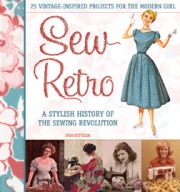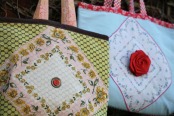But before we get to the questions, I wanted to share a little about how the whole process of selling my proposal worked. I had the idea for Sew Retro in the spring of 2007; I met my agent, Joy Tutela, on a trip to New York City in April. She read my one-page summary and loved it; we immediately clicked. (See Part One of this series for awesome tips from her.) I worked on the proposal throughout the summer and sent her the finished draft in September of 07. We worked on revising and sharpening it and then she sent it out in October; we started hearing back in November. The feedback was really all over the place, which was interesting. Some publishers loved the historical narrative concept, but weren’t as interested in projects. Others wanted a more straightforward project book using all vintage materials. And even the feedback on the projects was mixed: one publisher wanted to focus only on clothes, while another thought it would be stronger if it was just home dec/design. One publisher suggested that I team up with designers who made vintage clothing and accessories.
I tried to keep an open mind as we were getting feedback, because I didn’t want to completely discount anything. But I really still believed in the original idea. I was considering revamping the whole thing (or honestly, just scrapping it) when Margret Aldrich from Voyageur got in touch in the spring of 08. She totally got the concept of both projects and narrative and loved the idea. It still took quite a bit of time to negotiate everything (we each had maternity leaves in the process), but we had an unofficial deal by September, and the contract was signed in the next few months (another reason I’m so glad I had an agent: she negotiated every point for me, explained to me why we wanted certain changes, and worked to get the best deal possible in the contract). From the point of signing, I had about six months to finish all the projects, write all the text/instructions, draw all of the illustrations, and gather all of the vintage images. There were certainly moments of chaos and stress, but truthfully, it all went pretty darn smoothly (I’m sure that was due in large part because Aldrich was genuinely excited by the project and very organized).
The process of sending the proposal out and getting my hopes up each time and then having them dashed was rough. And I admit, I did almost give up when I didn’t get the initial “yes, we love this idea!” from every publisher. But once I found the right fit, it all worked and fell into place. My point in all of this is: if you believe in the idea (and your agent believes in the idea—which mine did), and you have solid workmanship, writing, and market data behind it, just keep trying.
As promised, a Q&A with Aldrich, who shares her thoughts on how to wow a publisher with your craft book proposal.
Q: What do you love to see in a craft book proposal? What gets you excited?
Aldrich: For a craft book proposal, fabulous, unique projects are key. I love to see a wide selection of projects with a strong point of view, and photographs are extremely helpful in getting your message across to potential publishers. Take the time to shoot well-lit, semi-stylish photos. (They don't need to be professional, but they do need to show off your work.) Your editor can help shape the organization of your book or your writing style, but the projects need to be solid and special from the get-go. A unique "hook" is also important, because there isn't room on bookshelves for ten books covering the same topic. In addition, I'm thrilled to find an author who is already immersed in the crafting world—perhaps blogging, attending shows, selling wares on Etsy or elsewhere, publishing one-off patterns, contributing to magazines and websites, etc.
Q: Now the flip side: what is a big turnoff in a proposal?
Aldrich: Projects or themes need to be ahead of trends, rather than following them. If something has already been done a million times, publishers likely don't want to see it, unless you have a new, unique perspective.
Q: What is the role of digital as we move forward?
Aldrich: Electronic media is becoming more and more important. As bookstores stock fewer books, we need to find new ways to bring an audience to our titles. Publishers are thrilled when authors are already established online through blogs, websites, or social media sites like Facebook and Twitter. After your book is published, a video is a great way to promote it via online booksellers like Amazon. They're like little commercials that can make a reader fall in love with your book.
[Me here with a note: check out the video I did for Sew Retro here]
Q: Are there areas in craft books that are really growing?
Aldrich: Sewing is still a hot topic and "designer" sewing shows signs of being on the rise, thanks to shows like Project Runway . In general, handmade and DIY subjects are still solid as readers search for ways to simplify and personalize their worlds.
Q: When you and your editorial board are meeting about a potential project/author, what are the biggest determining factors as to whether the project gets signed or not?
Aldrich: Publishers want to see proof (or at least an indication) that a book will sell. If you're proposing a book to a publisher, include title/author/publisher of other books similar to yours that have sold well. Include articles, facts, and numbers about your subject that prove readers are interested in it. Show that you have expertise on the topic (and ideally a huge following of adoring fans!). But most of all, again, focus on creating fabulous projects that readers will love to make.
Thanks so much to Margret Aldrich for answering my questions. Here are a few links you might find helpful:
- My fellow Voyageur author, Jennifer Worick, wrote a helpful article on this topic for Craftstylish.com.
- There’s also a good Craftypod podcast on this topic, and she includes a list of resources for more information as well.


 RSS Feed
RSS Feed